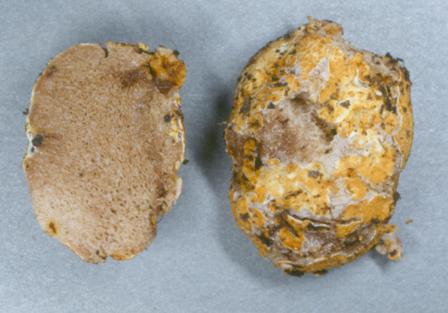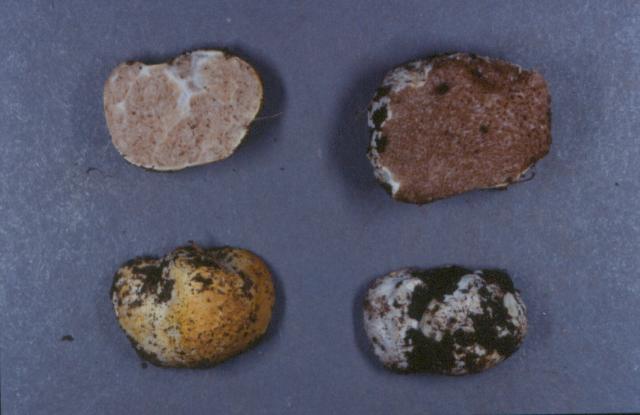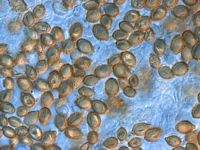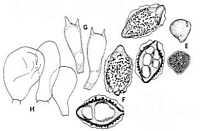|
 Descomyces albus Descomyces albus
SynonymsHymenogaster albus
Hymenangium album
BiostatusPresent in region - Exotic
Images (click to enlarge)
Caption: Descomyces albus, REB 1918
Owner: R.E. Beever | 
Caption: Descomyces albus, REB 1266
Owner: R.E. Beever | 
Owner: Herb PDD | 
Caption: Hymenogaster albus: E habit and section (Beaton 54) x 1;
F spores x 1750; G basidia x 1000; H epithelial
elements x 1000. | |
Article: Gadgil, P.D. (in association with Dick, M.A.; Hood, I.A.; Pennycook, S.R.) (2005). Fungi on trees and shrubs in New Zealand. Fungi of New Zealand. Ngā Harore o Aotearoa 4: xi + 437 p. Hong Kong: Fungal Diversity Press.
Description: Type: Mycorrhizal Fungi; Description: Basidiomata hypogeous, globose to subglobose, white at first, becoming lemon yellow when mature, 10–20 mm in diameter; peridium composed of a single layer, white or cream in section. Gleba ochraceous, becoming cinnamon brown, with irregularly shaped empty cells; columella reduced to a small sterile base. Basidiospores broadly elliptical to citriform, 0-septate, 17–23 × 10–17 μm (including the utricle), golden brown to dark brown, verruculose; utricle conspicuous, not covering the apex.
Distribution: Distribution: Coromandel, Bay of Plenty, Taupo.; 1st Record: Chu-Chou & Grace (1981b: as Hymenogaster albus).
Article: Beaton, G.W.; Pegler, D.N.; Young, T.W.K. (1985). Gasteroid Basidiomycota of Victoria State, Australia. 3. Cortinariales. Kew Bulletin 40(1): 167–204.
Description: asterocarp 0.5-2 cm diam., subglobose to
pyriform, basally attached. Peridium thin, dingy white to pallid yellowish brown,
glabrous, at times cracking, floccose and partially detersile. Gleba pale brown
to ferruginous, loculate, of irregular, empty or partially filled chambers,
very variable in size, without radial arrangement. Tramal plates up to 175 µm
thick, white, with a narrow hymenophoral trama and very broad subhymenial layers;
clamp-connexions present on all hyphae. Sterile base minute or none.
Spores 14-17(-19.5) x 7.5-11.5(16 ± 1 x 10
± 0.5) µm (excl. myxosp.), Q = 1.6; limoniform, deep golden brown to fuscous
brown, with a thickened wall bearing a coarsely rugulose exosporial ornamentation,
overlain by a loose membranous, hyaline myxosporium. Basidia 28-33 x 9-11 µm,
clavate, bearing two short sterigmata, and forming a regular palisadic hymenium.
Hymenophoral trama regular, hyaline, of inflated, thin-walled hyphae, 3-18 µm
diam. Subhymenial layer very well developed, 20-30 µm wide, pseudoparenchymatous.
Peridiopellis an agglutinated, stratified epithelium, of hyaline, thin-walled
elements, 26-40 x 13-30 µm, globose to pyriform.
Notes: Berkeley (1836: 229) gave the name 'Rhizopogon
albus Bull.' to material collected by J. D. Hooker in the Botanic Garden,
Glasgow, and this material was sent to Klotzsch. Klotzsch (1839) matched this
to material gathered in the botanic garden at Grunewald, near Berlin, and redescribed
it as Hymenangium albus Klotzsch, type species of the genus Hymenangium
Klotzsch. The Glasgow specimens, labelled 'Hymenangium album' by Klotzsch
are now located in the Kew Herbarium, whilst the Grunewald material is lost.
Dodge & Zeller (1934: 641) recorded collections from many north temperate
localities, in both Europe and North America, but commented that it was usually
collected in pots of cultivated plants in greenhouses, often associated with
eucalyptus, and Hawker (1954: 535) did not regard this species as indigenous
in Western Europe. Cribb (1956: 126) confirmed the occurrence of H. albus
in Australia, after matching Queensland collections to the Glasgow material.
It is likely that Cribb accepted a broad species concept for she commented on
the exceptional variability of the spore form, and her illustrations would suggest
that some of the collections included H. zeylanicus and H. nanus
in addition to H. albus. Examination of. H. albellus, based on
gasterocarps gathered in Tasmania by Rodway, confirms this to be a later synonym
of H. albus.
The mucronate spores and epithelial peridiopellis
indicate a close affinity with H. zeylanicus, differing in the shorter and less
fusoid spore-form. This is the most common and plentiful species of Hymenogaster
in Victoria State.
|